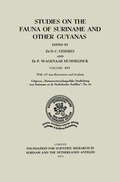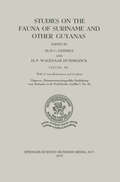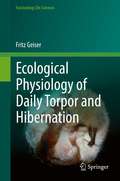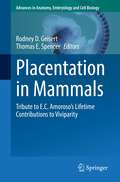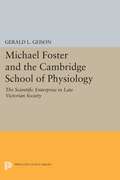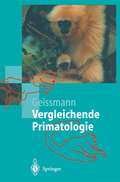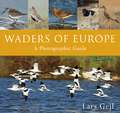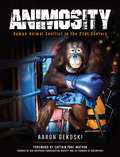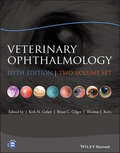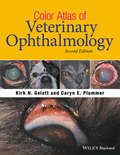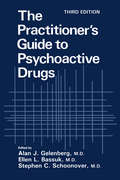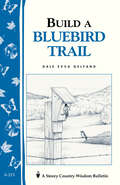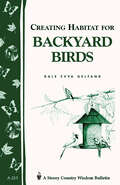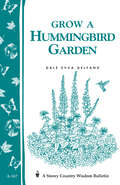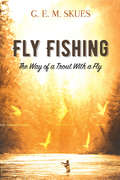- Table View
- List View
Studies on the Fauna of Suriname and other Guyanas: Volume XVI
by D.C. Geijakes P. Wagenaar HummelinckStudies on the Fauna of Suriname and other Guyanas: Volume XV
by D.C. Geijakes P. Wagenaar HummelinckEcological Physiology of Daily Torpor and Hibernation (Fascinating Life Sciences)
by Fritz GeiserThis book provides an in-depth overview on the functional ecology of daily torpor and hibernation in endothermic mammals and birds. The reader is well introduced to the physiology and thermal energetics of endothermy and underlying different types of torpor. Furthermore, evolution of endothermy as well as reproduction and survival strategies of heterothermic animals in a changing environment are discussed.Endothermic mammals and birds can use internal heat production fueled by ingested food to maintain a high body temperature. As food in the wild is not always available, many birds and mammals periodically abandon energetically costly homeothermic thermoregulation and enter an energy-conserving state of torpor, which is the topic of this book. Daily torpor and hibernation (multiday torpor) in these heterothermic endotherms are the most effective means for energy conservation available to endotherms and are characterized by pronounced temporal and controlled reductions in body temperature, energy expenditure, water loss, and other physiological functions. Hibernators express multiday torpor predominately throughout winter, which substantially enhances winter survival. In contrast, daily heterotherms use daily torpor lasting for several hours usually during the rest phase, some throughout the year. Although torpor is still widely considered to be a specific adaptation of a few cold-climate species, it is used by many animals from all climate zones, including the tropics, and is highly diverse with about 25-50% of all mammals, but fewer birds, estimated to use it. While energy conservation during adverse conditions is an important function of torpor, it is also employed to permit or facilitate energy-demanding processes such as reproduction and growth, especially when food supply is limited. Even migrating birds enter torpor to conserve energy for the next stage of migration, whereas bats may use it to deal with heat. Even though many heterothermic species will be challenged by anthropogenic influences such as habitat destruction, introduced species, novel pathogens and specifically global warming, not all are likely to be affected in the same way. In fact it appears that opportunistic heterotherms because of their highly flexible energy requirements, ability to limit foraging and reduce the risk of predation, and often pronounced longevity, may be better equipped to deal with anthropogenic challenges than homeotherms. In contrast strongly seasonal hibernators, especially those restricted to mountain tops, and those that have to deal with new diseases that are difficult to combat at low body temperatures, are likely to be adversely affected. This book addresses researchers and advanced students in Zoology, Ecology and Veterinary Sciences.
Placentation in Mammals: Tribute to E.C. Amoroso’s Lifetime Contributions to Viviparity (Advances in Anatomy, Embryology and Cell Biology #234)
by Rodney D. Geisert Thomas E. SpencerThe present volume of the book series Advances in Anatomy, Embryology and Cell Biology brings together current reviews from leading experts to address the diversity of placentation by which species establish and maintain pregnancy. Development of viviparity and placentation in rodents, dogs, pigs, cattle, horses, marsupials, primates and elephants are discussed. The development of viviparity in mammals, including some invertebrate species, required the adaptation of the placenta to serve as a functional conduit for interplay between the semiallograftic fetus with the maternal uterus. Although the ‘placenta’ protects the fetus from maternal immune rejection and provides oxygen and nutrient flow to support it to term across all the species, structural differentiation of this fetal-maternal interface can vary from simple to very complex. E.C. Amoroso contributed greatly to our early understanding and knowledge of placentation across a great variety of species. His work on placentation provides numerous illustrations and histological sections which are used for teaching and stimulating research today. With this book, we want to pay tribute to his lifetime contributions to the field by reviewing our current understanding of the development of viviparity and placentation in different species. The book is written for researchers, physicians and medical students working in the field of reproductive science or with an interest in placentation and viviparity.
Michael Foster and the Cambridge School of Physiology: The Scientific Enterprise in Late Victorian Society
by Gerald L. GeisonDespite great ferment and activity among historians of science in recent years, the history of physiology after 1850 has received little attention. Gerald Geison makes an important contribution to our knowledge of this neglected area by investigating the achievements of English physiologists at the Cambridge School from 1870 to 1900. He describes individual scientists, their research, the scientific issues affecting their work, and socio-institutional influences on the group. He pays special attention to the personality and contributions of Michael Foster, founding father of the Cambridge School. Foster's specific research interest was the origin of the rhythmic heartbeat, and the author contends that the school itself descended from and developed around this concern.Originally published in 1978.The Princeton Legacy Library uses the latest print-on-demand technology to again make available previously out-of-print books from the distinguished backlist of Princeton University Press. These editions preserve the original texts of these important books while presenting them in durable paperback and hardcover editions. The goal of the Princeton Legacy Library is to vastly increase access to the rich scholarly heritage found in the thousands of books published by Princeton University Press since its founding in 1905.
Vergleichende Primatologie (Springer-Lehrbuch)
by Thomas GeissmannDas Buch ist seit 30 Jahren das einzige deutschsprachige Lehrbuch zur vergleichenden Primatologie. Es vermittelt in konzentrierter Form einen Überblick über die Biologie unserer nächsten Verwandten: die Primaten. Der Band berücksichtigt neueste Erkenntnisse und Entwicklungen auf allen wichtigen Gebieten der Primatenbiologie: Anatomie, Anthropologie, Artenschutz, Ethologie, Evolutionsbiologie, Genetik, Morphologie, Ökologie, Systematik, Taxonomie und Wissenschaftsgeschichte. Eine einführende Gesamtdarstellung der modernen Primatologie für Studenten.
Waders of Europe
by Lars GejlWaders are spectacular members of our avifauna. They are especially prevalent along coasts and in wetlands during the spring and autumn migration periods, when members of several species may perform dramatic flocks that wheel and turn in flight. While waders are often particularly striking in summer plumage, identifying these birds outside the breeding season can be problematic for even the most confident of birdwatchers.Waders of Europe is the ultimate guide to wader identification, ecology and biology. Through outstanding photography and concise, detailed text, this book is indispensable for anyone interested in learning more about waders, and is an invaluable tool for identifying birds to species level in the field.
Animosity: Human-Animal Conflict in the 21st Century
by Aaron GekoskiThe world’s wildlife is in crisis.Globally, animals are being traded, hunted, poached, consumed and exploited to the point of extinction. This is their story, as told through the lens and eyes of Aaron ‘Bertie' Gekoski, an internationally acclaimed environmental photojournalist, who documents human-animal conflict in the most inhospitable places on Earth.ANIMOSITY is a collection of powerful photographs and absorbing tales from the frontline of conservation: from Cambodia’s dog-drowning dungeons and West Africa’s voodoo markets, to cruel Wildlife Tourism Attractions and the shadowy world of the exotic pet trade.Conflict, conservation, and the battle to coexist: ANIMOSITY is the story of our generation, our legacy.Numerous animal welfare NGOs have lent their backing to the book including Born Free Foundation, Four Paws, World Animal Protection, International Animal Rescue, PETA & Scubazoo, while world famous actresses Shannon Elizabeth and Amy Jackson have written moving testimonies for the book.The foreword has been written by one of the best-known environmental activists in the world, Captain Paul Watson, founder of the Sea Shepherd conservation society and a co-founder of Greenpeace.
Essentials of Veterinary Ophthalmology
by Kirk N. GelattEssentials of Veterinary Ophthalmology, Third Edition offers an updated introduction to the diagnosis and clinical management of ocular conditions in veterinary patients, providing trusted information in a user-friendly format. The content of the book is distilled from the fifth edition of the gold-standard reference Veterinary Ophthalmology, emphasizing the information most relevant to veterinary students and general practitioners. Fully updated throughout, the Third Edition focuses more strongly on small animals and horses, with streamlined coverage of other species, and new chapters have been added on morphology, physiology, and pharmacology. Carefully designed to be equally useful for learning and in practice, the book offers a streamlined, practical approach, with bolded terms to enhance comprehension. High-quality color photographs provide visual depictions of the conditions discussed. Essentials of Veterinary Ophthalmology, Third Edition is an indispensable resource for veterinary students or clinicians wishing to hone their ophthalmology knowledge and skills.
Essentials of Veterinary Ophthalmology
by Kirk N. GelattEssentials of Veterinary Ophthalmology, Third Edition offers an updated introduction to the diagnosis and clinical management of ocular conditions in veterinary patients, providing trusted information in a user-friendly format. The content of the book is distilled from the fifth edition of the gold-standard reference Veterinary Ophthalmology, emphasizing the information most relevant to veterinary students and general practitioners. Fully updated throughout, the Third Edition focuses more strongly on small animals and horses, with streamlined coverage of other species, and new chapters have been added on morphology, physiology, and pharmacology. Carefully designed to be equally useful for learning and in practice, the book offers a streamlined, practical approach, with bolded terms to enhance comprehension. High-quality color photographs provide visual depictions of the conditions discussed. Essentials of Veterinary Ophthalmology, Third Edition is an indispensable resource for veterinary students or clinicians wishing to hone their ophthalmology knowledge and skills.
Veterinary Ophthalmic Surgery - E-Book
by Kirk N. Gelatt Janice P. Gelatt Caryn PlummerPurchasers of Veterinary Ophthalmic Surgery have at their disposal a comprehensive, step-by-step guide to all types of ophthalmic surgical techniques across all species. Techniques are covered topographically, and species-by-species, with difficulty gradings for each one. Many of these procedures will be undertaken by the veterinary generalist, not only the specialized ophthalmologist. Nearly 1,000 large-sized illustrations, 750 of them in full colour, allow the practitioner to follow the techniques step-by-step. Internationally recognized as an authority on small animal ophthalmic surgery, Dr Gelatt is joined by expert contributors who together provide authoritative and definitive solutions to practitioners' eye surgery requirements. Whatever your field of specialism, this is the only eye surgery book you are ever likely to need. For: residents in veterinary ophthalmology; general, small animal, and equine veterinary practitioners; veterinary ophthalmologists; veterinary medicine students. -Comprehensive coverage of all species -Lavishly illustrated sequenced figures of all procedures -Step-by-step approach for maximum clarity -A superb collection of online video clips gives clarification of the most common procedures -The only ophthalmic surgery text for veterinarians
Veterinary Ophthalmic Surgery - E-Book
by Kirk N. Gelatt Janice P. Gelatt Caryn PlummerVeterinary Ophthalmic Surgery - E-Book
Veterinary Ophthalmology: Two Volume Set
by Kirk N. Gelatt Brian C. Gilger Thomas J. KernVeterinary Ophthalmology, Fifth Edition is a fully updated version of the gold-standard reference for diseases and treatment of the animal eye in veterinary medicine. With an internationally renowned list of contributing authors, the book has been revised and expanded to incorporate the most up-to-date research and information. New chapters cover ophthalmic genetics and DNA tests, microsurgery, photography, camelid ophthalmology, and rabbit ophthalmology, and existing chapters feature expanded coverage of noninvasive imaging techniques, feline ophthalmology, equine ophthalmology, and marine mammals and penguins. The book retains its classic structure, with sections on basic vision sciences, the foundations of clinical ophthalmology, canine ophthalmology, and special ophthalmology, which encompasses specific coverage of most commonly treated species and chapters on neuro-ophthalmology and systemic diseases. A companion website offers the images from the book available for download in PowerPoint and the references linked to CrossRef. Veterinary Ophthalmology remains the most comprehensive resource for authoritative information on veterinary ophthalmology worldwide and is a key reference for anyone interested in veterinary or comparative ophthalmology.
Veterinary Ophthalmology: Two Volume Set
by Kirk N. Gelatt Brian C. Gilger Thomas J. KernVeterinary Ophthalmology, Fifth Edition is a fully updated version of the gold-standard reference for diseases and treatment of the animal eye in veterinary medicine. With an internationally renowned list of contributing authors, the book has been revised and expanded to incorporate the most up-to-date research and information. New chapters cover ophthalmic genetics and DNA tests, microsurgery, photography, camelid ophthalmology, and rabbit ophthalmology, and existing chapters feature expanded coverage of noninvasive imaging techniques, feline ophthalmology, equine ophthalmology, and marine mammals and penguins. The book retains its classic structure, with sections on basic vision sciences, the foundations of clinical ophthalmology, canine ophthalmology, and special ophthalmology, which encompasses specific coverage of most commonly treated species and chapters on neuro-ophthalmology and systemic diseases. A companion website offers the images from the book available for download in PowerPoint and the references linked to CrossRef. Veterinary Ophthalmology remains the most comprehensive resource for authoritative information on veterinary ophthalmology worldwide and is a key reference for anyone interested in veterinary or comparative ophthalmology.
Color Atlas of Veterinary Ophthalmology
by Kirk N. Gelatt Caryn E. PlummerColor Atlas of Veterinary Ophthalmology, Second Edition provides a compendium of the clinical appearance of ophthalmic diseases likely to be encountered in small, large, or exotic animal practice. Offers a pictorial reference to the clinical appearance of diseases and conditions of the animal eye Presents multiple presentations of most ophthalmic diseases to show the varying ways the condition might appear Provides more than 1,000 high-quality color clinical photographs showing ocular disorders Includes new introductory chapters on ocular anatomy, the ophthalmic exam, and clinical findings in place of the clinical signs chapter Covers clinical history, the clinical signs and findings associated with the disease, the rule-outs or differential diagnoses, the recommended treatment, and the prognosis for each disorder
Color Atlas of Veterinary Ophthalmology
by Kirk N. Gelatt Caryn E. PlummerColor Atlas of Veterinary Ophthalmology, Second Edition provides a compendium of the clinical appearance of ophthalmic diseases likely to be encountered in small, large, or exotic animal practice. Offers a pictorial reference to the clinical appearance of diseases and conditions of the animal eye Presents multiple presentations of most ophthalmic diseases to show the varying ways the condition might appear Provides more than 1,000 high-quality color clinical photographs showing ocular disorders Includes new introductory chapters on ocular anatomy, the ophthalmic exam, and clinical findings in place of the clinical signs chapter Covers clinical history, the clinical signs and findings associated with the disease, the rule-outs or differential diagnoses, the recommended treatment, and the prognosis for each disorder
Essentials of Veterinary Ophthalmology
by Kirk N. Gelatt Caryn E. PlummerA user-friendly reference to basic, foundational information on veterinary ophthalmology This book provides readers with a user-friendly manual to the basics of veterinary ophthalmology. It puts a focus on the most relevant information for clinical practice. Emphasizing canine ophthalmology, the book also covers the foundations of feline, equine, farm animal, and exotic animal ophthalmology. To aid in reader comprehension and information assimilation, a companion website presents review questions and the figures from the book in PowerPoint. Sample topics covered within the work include: Ophthalmic foundations: ophthalmic development and structure, physiology of the eye and vision, and ocular pharmacology and therapeutics Canine ophthalmology: canine orbit (disease and surgery), canine eyelids (disease and surgery), canine lacrimal apparatus (tear secretion and drainage), canine cornea (diseases and surgery) and canine glaucoma Other species: feline ophthalmology, equine ophthalmology, and food and fiber animal ophthalmology Ophthalmic and systemic diseases: comparative neuro-ophthalmology and systemic disease and the eye Essentials of Veterinary Ophthalmology is a useful guide for veterinary students and practitioners looking to build out their core foundations of knowledge within their specific programs of study and disciplines.
Essentials of Veterinary Ophthalmology
by Kirk N. Gelatt Caryn E. PlummerA user-friendly reference to basic, foundational information on veterinary ophthalmology This book provides readers with a user-friendly manual to the basics of veterinary ophthalmology. It puts a focus on the most relevant information for clinical practice. Emphasizing canine ophthalmology, the book also covers the foundations of feline, equine, farm animal, and exotic animal ophthalmology. To aid in reader comprehension and information assimilation, a companion website presents review questions and the figures from the book in PowerPoint. Sample topics covered within the work include: Ophthalmic foundations: ophthalmic development and structure, physiology of the eye and vision, and ocular pharmacology and therapeutics Canine ophthalmology: canine orbit (disease and surgery), canine eyelids (disease and surgery), canine lacrimal apparatus (tear secretion and drainage), canine cornea (diseases and surgery) and canine glaucoma Other species: feline ophthalmology, equine ophthalmology, and food and fiber animal ophthalmology Ophthalmic and systemic diseases: comparative neuro-ophthalmology and systemic disease and the eye Essentials of Veterinary Ophthalmology is a useful guide for veterinary students and practitioners looking to build out their core foundations of knowledge within their specific programs of study and disciplines.
The Practitioner’s Guide to Psychoactive Drugs
by Alan J. Gelenberg Ellen L. Bassuk Stephen C. SchoonoverIn the eight years since the publication of the second edition of this Guide, psycho phannacotherapy has made many advances not only through the discovery of new medications but by the effective directing of their use to an ever-increasing variety of clinical disorders. These welcome developments are reflected in the concurrent growth and development of the Guide itself, which now enters adulthood with renewed vigor. Under the thoughtful and scholarly leadership of Dr. Alan Gelenberg, the third edition has undergone a significant transformation designed to meet the needs of the modem clinician. The panel of contributors is nearly double that of the former edition with the addition of nine new authors, who have helped in the major revision and rewriting of the text and in a broadening of the topics included. As a conse quence, the reader is assured of a thorough and thoroughly up-to-date coverage of current psychopharmacology that is both accurate and aimed at clinical utility. Having reached maturity, the third edition, while maintaining the lineaments of its earlier versions, is a considerably expanded and strengthened guide to treatment. Although now more encyclopedic in content, the new Practitioner' s Guide to Psy choactive Drugs retains the virtues of a clinical vade mecum that informed its predecessors and have eamed it a place by the patient's bedside for weIl over a decade. One may confidently anticipate its long and flourishing career in the years ahead. John C. Nemiah, M.D.
Build a Bluebird Trail: Storey's Country Wisdom Bulletin A-213 (Storey Country Wisdom Bulletin)
by Dale Evva GelfandConservationists across North America are working to help protect and support bluebirds, and you can do your part by creating a bluebird trail. This is simply a series of nesting boxes (anywhere from a few to a few thousand) set about 300 feet apart along a prescribed route. Dale Gelfand tells you what you need to know about bluebirds and their habits, and she shows you how to create and monitor an effective bluebird trail with well-designed nesting boxes.
Creating Habitat for Backyard Birds: Storey's Country Wisdom Bulletin A-215 (Storey Country Wisdom Bulletin)
by Dale Evva GelfandSince 1973, Storey's Country Wisdom Bulletins have offered practical, hands-on instructions designed to help readers master dozens of country living skills quickly and easily. There are now more than 170 titles in this series, and their remarkable popularity reflects the common desire of country and city dwellers alike to cultivate personal independence in everyday life.
Grow a Hummingbird Garden: Storey's Country Wisdom Bulletin A-167 (Storey Country Wisdom Bulletin)
by Dale Evva GelfandSince 1973, Storey's Country Wisdom Bulletins have offered practical, hands-on instructions designed to help readers master dozens of country living skills quickly and easily. There are now more than 170 titles in this series, and their remarkable popularity reflects the common desire of country and city dwellers alike to cultivate personal independence in everyday life.
The Loved Dog: The Gentle Way to Teach Your Dog Good Manners
by Tamar GellerThe Loved Dog is Tamar Geller's revolutionary guide to effective dog-training using the gentlest of methods. Tamar, whose clients include Oprah Winfrey, Ben Affleck and Goldie Hawn, teaches a groundbreaking socialisation technique for training dogs. By strengthening the bond between dog and owner, dogs begin to enjoy listening to commands with no need for aggressive training aids such as verbal or physical reprimands. Using this technique, The Loved Dog shows you how to child-proof your dog and teach him good behaviour.Tamar's amazing methods have swept across America, changing the way owners train and relate to their canine friends. Tamar believes that loving your dog is the key to its training. In The Loved Dog she shows you how to build this relationship.
Die Wildnis und wir: Geschichten von Intelligenz, Emotion und Leid im Tierreich
by Georg GellertObwohl die Menschheit bereits das Wissen hat, um unsere Nachbarplaneten aufsuchen zu können, sind ihre Kenntnisse, was die eigene Umgebung anbetrifft, immer noch bruchstückhaft. Dabei gibt es auch auf der Erde noch so viel zu entdecken! Das Wesen von möglichen außerirdischen Organismen könnte uns nicht mehr überraschen als unsere eigenen Mitbewohner, die Wildtiere. Ihre besonderen Fähigkeiten übertreffen bei weitem den eigenen Entwicklungsstand. Der Autor lenkt das Augenmerk aber auch auf das trostlose und gefahrvolle Leben in der Wildnis. Der Mensch hat es glücklicherweise weitgehend geschafft, sich daraus zu befreien. Aber was machen wir mit unseren Weggefährten? Haben wir hier eine moralische Verpflichtung? Eine Antwort darauf würde uns auch helfen, unsere Heimat wieder als das zu erkennen was sie ist, nämlich ein blaues Juwel im lebensfeindlichen Weltraum.
Fly Fishing: The Way of a Trout With a Fly
by G.E.M. SkuesAttorney G. E. M. Skues drew upon his vast experience as a recreational fisherman to write this masterpiece of the fly fishing genre, in which he established sunken flies as essential tools for the well-equipped angler. Originally published in 1921, this seminal book retains its relevance in a world in which the quiet pleasures of river fishing remain unchanged. Professional, competitive, and amateur fishermen as well as beginners will appreciate its timeless wisdom.
